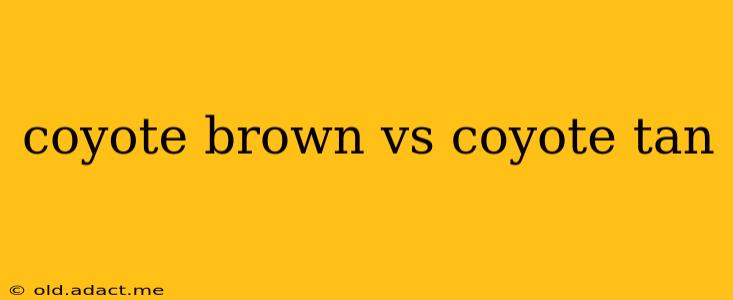Choosing the right camouflage can be crucial, especially for serious outdoor enthusiasts, hunters, and military personnel. Two colors frequently causing confusion are Coyote Brown and Coyote Tan. While seemingly similar, subtle differences exist that impact their effectiveness and suitability for various environments. This comprehensive guide will dissect the nuances between Coyote Brown and Coyote Tan, helping you make an informed decision based on your specific needs.
What is Coyote Brown?
Coyote Brown is a muted, earthy brown tone. It's designed to blend seamlessly with arid and desert environments, offering effective concealment in landscapes dominated by sand, rocks, and sparse vegetation. Think dusty plains, rocky canyons, and dry brush. Its darker shade offers better concealment in areas with more shadow and less direct sunlight. It's often a more saturated brown than Coyote Tan, lending itself well to tactical gear and clothing.
What is Coyote Tan?
Coyote Tan, on the other hand, is a lighter, more sandy brown. It’s closer to the color of bleached sand or light-colored earth. This makes it a superior choice for extremely bright, sunny environments where a darker shade like Coyote Brown might stand out. Think open deserts or sandy beaches. The lighter hue helps it better integrate with the brighter tones of these landscapes.
Coyote Brown vs. Coyote Tan: Key Differences
The primary difference lies in the shade and saturation of the brown. Coyote Brown is a deeper, richer brown, while Coyote Tan is significantly lighter and less saturated. This seemingly small difference can make a substantial impact on camouflage effectiveness depending on the environment and lighting conditions.
Which color is better for camouflage?
The "better" color depends entirely on the environment.
- Coyote Brown: Ideal for environments with shadows, rocky terrain, and areas with less intense sunlight. It performs well in more varied terrain with a mix of light and dark elements.
- Coyote Tan: Best suited for bright, sunny environments such as open deserts or sandy beaches where a lighter tone blends more effectively.
How do manufacturers define these colors?
It's important to note that there isn't a universally standardized definition for Coyote Brown and Coyote Tan. Different manufacturers may use slightly varying shades under these names. Always refer to the manufacturer's specific color charts and descriptions to ensure consistency if you're purchasing multiple items or needing color matching.
What are the other colors often confused with Coyote Brown and Coyote Tan?
Several other camouflage colors share a similar color palette and can be easily confused with Coyote Brown and Coyote Tan. These include:
- Khaki: Often a lighter, more yellowish-brown.
- Sand: A very light, almost white-beige.
- Ranger Green: A darker, more olive-green.
What about the material? Does it matter?
The material of the clothing or gear also influences the overall appearance of the color. Different fabrics absorb and reflect light differently, affecting the final shade. A Coyote Brown garment made of a heavy cotton will look different than a Coyote Brown garment made from a lightweight nylon.
Conclusion: Choosing the Right Shade
Ultimately, the best choice between Coyote Brown and Coyote Tan hinges on the specific environment you'll be using the gear in. Consider the prevalent lighting conditions, the type of terrain, and the level of concealment required to make an informed decision. Remember that paying close attention to the manufacturer’s specifications is key to ensuring consistency and effective camouflage.
